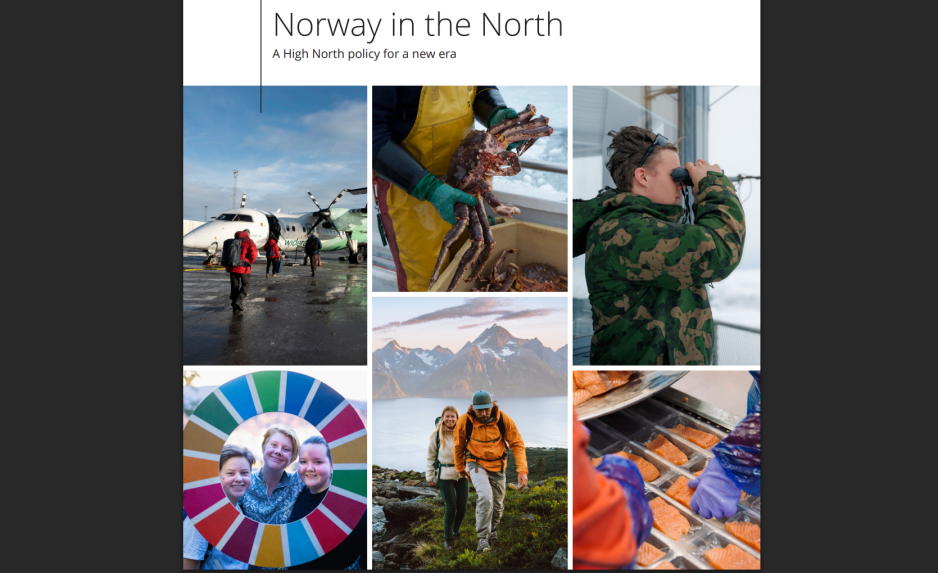Op-ed: From Policy to Practice: Advancing Norway’s High North Policy Through ArcBlue Collaboration

The aim of Norway’s High North strategy is to ensure that North Norway is home to vibrant local communities where people want to live, and that enhance our national security and preparedness. It was published in September 2025. (Source: Ministry of Foreign Affairs of Norway)
This is an op-ed written by an external contributor. All views expressed are the writer's own.
In August 2025, the Norwegian government presented its updated strategy for the High North, “Norway in the North: High North Policy in a New Reality.”
The policy highlights the importance of Norway’s influence, close cooperation with allies, and sustainable development of the High North region.
Geographically, the nordområdene refers to the land and sea areas between southern Helgeland in the south, the Greenland Sea in the west, and the Pechora Sea (the southeastern corner of the Barents Sea) in the east – a region of growing geopolitical and economic significance for Norway.
Consequently, the updated strategy focuses on safeguarding Norway’s freedom of action in the region, strengthening total defence to ensure security and preparedness, supporting safe and vibrant local communities, investing in infrastructure that connects and sustains them, and promoting business development that creates lasting value.
It is no coincidence that the front page of the document, alongside other illustrations of Norway’s interests, features a king crab fishery and a farmed salmon processing plant – two industries that are central to the Norwegian economy.
The policy also recognizes several persistent challenges
The policy emphasizes that sustainability, transformation, and growth in the seafood sector are key to maintaining and developing value-creating industries in the High North In this context, the government underscores a proactive approach to addressing challenges in the seafood industry while fostering innovation, promoting sustainability, and supporting coexistence between fisheries and aquaculture in Norway’s northernmost areas.
However, the policy also recognizes several persistent challenges. The traditional fishing industry faces difficulties in maintain year-round operations due to seasonal variations, quota reductions, and global competition for raw materials.
Strict regulations and the need to adapt to these constraints add further complexity, while quota reductions not only limit production but also increase the risk of future illegal activities.
Environmental uncertainties and gaps in knowledge, combined with the inherent seasonal and operational challenges of the industry, continue to pose significant hurdles.
The policy emphasizes the need to address these issues proactively to ensure the long-term sustainability and growth of both fisheries and aquaculture in the High North.
Also read (The text continues)
Addressing Knowledge Gaps through the ArcBlue International Research Efforts
The ArcBlue project—Enhanced Blue Economy Collaboration across Alaska, Greenland, and Northern Norway (2022–2025)—funded by the Norwegian Ministry of Foreign Affairs under the Arctic 2030 framework, provides a comprehensive approach to bridging knowledge gaps in Arctic seafood industries while supporting the goals outlined in Norway’s updated High North policy.
By conducting comparative research across Northern Norway, Alaska and Greenland, the project seeks to foster blue value creation, strengthen skills and competence development, and promote knowledge exchange and cooperation across the fisheries and aquaculture sectors.
In Spring 2024, ArcBlue published a scientific report—the first comparative assessment of the blue economy across Northern Norway, Alaska, and Greenland—with a focus on seafood industries.
The report highlighted key strengths, challenges, and opportunities for cross-boundary cooperation to build a resilient and sustainable ocean economy.
The findings provide a comprehensive understanding of the common challenges and opportunities shaping blue economy development across the Arctic, drawing on insights from academics, policymakers, entrepreneurs, and local and Indigenous communities directly involved in these industries.
The Guidelines provide a practical framework for phased implementation across four pillars
ArcBlue Guidelines for Policymakers
Building on the project’s main findings and stakeholder insights, the ArcBlue Guidelines for Policymakers have been published this October to distil the project’s key outcomes into a clear roadmap of policy recommendations.
The Guidelines provide a practical framework for phased implementation across four pillars: economic development, environmental sustainability, socio-cultural inclusion, and effective governance.
Each pillar reflects the core areas explored through the ArcBlue project and its comparative assessment of 2024.
The ArcBlue Guidelines have the potential to give real momentum to Norway’s updated High North policy by turning broad ambitions into practical action.
Focusing on sustainable infrastructure, local engagement, innovation, and cross-border cooperation, the Guidelines provide concrete tools to strengthen Norway’s freedom of action and influence in the North, while ensuring that growth in the blue economy supports security, environmental resilience, and thriving communities.
Also read (the text continues)
They closely align with the government’s priorities for the High North: building strong local communities, developing infrastructure that connects and sustains them, and fostering industries that create long-term value.
By implementing the ArcBlue Guidelines, Norway can anchor its High North strategy in tested regional best practices and data-driven solutions.
The Guidelines’ focus on Indigenous participation, traditional knowledge, and community-based resource management mirrors the updated policy’s goal of fostering safe, resilient, and inclusive northern societies.
At the same time, ArcBlue’s emphasis on innovation, circular economy principles, and cross-border governance cooperation could support Norway’s push for sustainable business development and stronger Nordic ties.
In this way, the Guidelines offer a practical roadmap for advancing the State’s High North policy, grounding national ambitions in regional capacity, collaboration, and the long-term sustainability of seafood industries within and across national borders.
They do not reduce the importance—or the potential—of well-targeted, regionally driven action.
Transboundary Cooperation Matters
Today, Arctic seafood industries operate in an increasingly uncertain political landscape. Rising geopolitical tension and fragmentation and across the circumpolar region create challenges for cross-border engagement and collaboration.
While recent geopolitical developments may influence the pace and scope of international collaboration, they do not reduce the importance—or the potential—of well-targeted, regionally driven action.
In this context, the ArcBlue Guidelines should be viewed not as a single, comprehensive plan to be implemented all at once, but rather as a structured set of priorities designed to guide step-by-step progress, drawing on transboundary collaboration and best practices across the Arctic.
Some recommendations are already being applied in parts of the region and could be scaled up or adapted quickly, while others will require longer-term policy alignment or new investment frameworks.
The High North remains a top priority for Norway, as recently reaffirmed in the Government’s High North Policy, which expresses strong ambitions for the development of the region.
The ArcBlue Guidelines are concrete and could serve as a critical starting point for realizing some of these ambitions. There are many practical ways in which this work could proceed — but most important is that it begins now.



